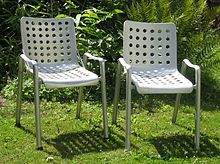Landi chair
The Landi chair is a hardened aluminum chair designed by Hans Coray (1906–1991) for the 1939 Swiss National Exhibition (“Landi”). The shell chair is a Swiss design classic and one of the best-selling outdoor chairs of the 20th century.
history
Hans Coray's design for a chair model emerged in 1938 from a chance encounter with Hans Fischli (assistant to the chief architect of the 1939 national exhibition). The chair was to be distributed in a number of 1,500 in the «Landi» exhibition area. The P. & W. Blattmann Metallwarenfabrik Wädenswil was commissioned to ensure the development and manufacture of the chair, which is very ambitious in terms of both time and technology, while assuming costs and risks.
Aluminum was to be used as the material for the major event, which was dominated by national self-assertion in the 1930s (“ intellectual national defense ”), as this was considered a typical Swiss metal. A significant aluminum industry had established itself in the country during the first half of the 20th century, after the large amount of electrical energy required for aluminum production ( fused salt electrolysis ) had become available thanks to the then accelerated construction of hydropower plants . The Swiss aluminum industry had its own pavilion at the “Landi”.
After the end of the national exhibition, the chairs were available to visitors for fifteen francs each. The Landi chair continued to be produced by P. & W. Blattmann Metallwarenfabrik Wädenswil (MEWA) from 1948 onwards. From 1970 the Italian company Zanotta sold it under the name "Spartana" in Italy and Germany. In 1998 Metalight AG took over production from Mewa. The bankruptcy of Metalight AG in 2001 and legal disputes led to the end of production. Between 2007 and 2012, the chair was manufactured again in the original design by the Swiss Westermann AG . The Swiss company Vitra has been producing the Landi chair since 2014 , after working with Henriette Coray to return the design to the original shell shape and detailing and at the same time to adapt it to today's standards.
The Landi chair is characterized by its suitability for mass production, weather resistance and ease of use: it consists of an aluminum alloy, weighs only three kilograms and can be stacked. When it was introduced, it caused a sensation not only because of its convincing form and functionality, but also because of its industrial production, in which material science studies by the Swiss Federal Railways (SBB) were incorporated. Important aspects of the Landi chair were special methods of hardening and surface treatment as well as the use of punching and pressing in production. The characteristic perforation of the seat shell originated from aircraft construction and, in addition to being more rigid, gave the chair both visual and physical lightness. In 1962, the design was modified by making only six instead of the original seven holes and only 60 instead of a total of 91 holes in order to counteract fatigue cracks that sometimes formed in the transition between the seat and backrest area. Thanks to modern production methods, the Landi chair has been able to be manufactured in its original form with 91 holes since 2014 without the above-mentioned quality defects.
Elastic caps on the feet were not added until the end of the 1950s. They were not originally used because the chair was only intended for outdoor use.
The Landi chair is considered a pioneer of modern aluminum chairs. In 1933, the parent company of the Swiss Aluminum Works in Paris announced a competition for an aluminum chair. ( Walter Gropius and Le Corbusier were on the jury, Marcel Breuer won first prize.) The Landi chair is a typical example of industrial design . In 1949 he was honored with the " Die gute Form " award. It is represented in the major design museums, such as the Museum of Modern Art in New York or the Vitra Design Museum in Weil am Rhein. The Swiss Post has the UHL 2004 as motive of the one-franc stamp added to its series about Swiss Design (next to the pencil " Fixpencil " by Caran d'Ache , the Swiss Railway Clock , the zipper " RiRi " and peeler " Rex ").
literature
- Alexander von Vegesack, Peter Dunas, Mathias Schwartz-Clauss (eds.): 100 masterpieces from the collection of the Vitra Design Museum , Weil am Rhein 1996, ISBN 3-9804070-2-0 .
- Museum of Design Zurich: Hans Coray - artist and designer (Swiss design pioneers 3). Zurich 1986.
- Adrian Scherrer, Wädenswil: "The Landi chair", cultural history presentation as a brochure, 2007
Web links
- The Landi chair. Website of Blattmann Metallwarenfabrik AG, Wädenswil
- Landi Chair Entry and picture on the MoMA website
- Improvement of the sitting position on "large chairs" (8.)
- Vitra - Production movie Landi Chair on YouTube , October 24, 2017, accessed on July 29, 2018.
- Landi chairs in a photograph by Hans Baumgartner
Individual evidence
- ↑ goodform Comeback of a design icon
- ↑ Westermann AG The End of the Landistuhl ( Memento of the original from July 21, 2013 in the Internet Archive ) Info: The archive link was inserted automatically and has not yet been checked. Please check the original and archive link according to the instructions and then remove this notice. (PDF; 212 kB)
- ↑ good shape Vitra Landistuhl, Hans Coray, 1938
- ↑ Vitra Landi-Stuhl, Hans Coray, 1938 ( page no longer available , search in web archives ) Info: The link was automatically marked as defective. Please check the link according to the instructions and then remove this notice.
- ↑ a b The Delft Collection (2008), p. 76

